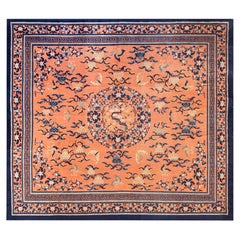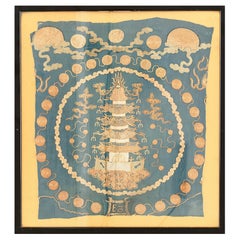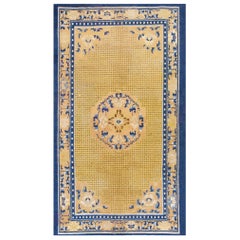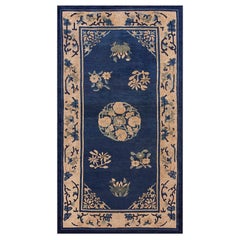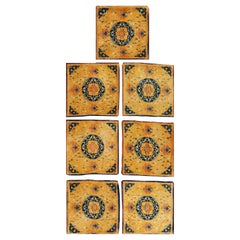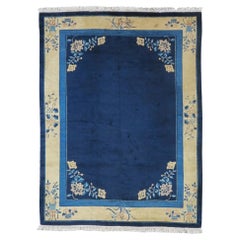Early 1800s Chinese and East Asian Rugs
16
to
9
16
16
16
16
53
562
3,321
968
2,125
628
320
204
129
1,132
186
45
33
79
60
70
23
Width
to
Length
to
16
14
2
16
16
16
Period: Early 1800s
Early 19th Century Chinese Ningxia Carpet ( 10 8" x 12' - 325 x 365 )
Located in New York, NY
Early 19th Century Chinese Ningxia Carpet ( 10 8" x 12' - 325 x 365 )
Category
Chinese Antique Early 1800s Chinese and East Asian Rugs
Materials
Wool
Early 19th Century Chinese Silk Embroidery ( 1'9"x 1'10" - 53 x 56 )
Located in New York, NY
Early 19th Century Chinese Silk Embroidery ( 1'9"x 1'10" - 53 x 56 )
Category
Chinese Antique Early 1800s Chinese and East Asian Rugs
Materials
Silk
Late 18th Century Chinese Ningxia Kang Carpet ( 6' x 10'3" - 175 x 415 )
Located in New York, NY
Late 18th Century Chinese Ningxia Kang Carpet ( 6' x 10'3" - 175 x 415 )
Ningxia or Suiyuan, North Central China
K’ang Carpet
Structural Analysis
Warp: cotton, off-white, natural, handspun, Z-4-S;
Weft: cotton, off white, natural, winder plied, Z-3-S. handspun, two shoots alternating;
Pile: wool, Z-3 or Z-4;
Knot: PL,no alternate warp depression, 5 ½ per horizontal inch x 5 per vertical inch = 27 ½ per square inch;
Sides: recovered;
Ends: n.o.
Weft/knots: 50/50, even.
Peach border, medallion and corners corroded; sapphire blue highest.
Remarks.
The golden yellow field employs the classic “grains of rice” pattern with brown pips,
centered by a broadly drawn peach scalloped peony medallion and en-suite corners.
The matching peach tone border has inward facing peonies in one, two or three
colors with short arabesque segments between. There is no corner resolution with
diagonal palmettes. The inner medium dark blue border is pearled and the outermost
stripe is plain as is characteristic of rugs of the period.
The peony corners are bold and direct, without a plethora of intrusive minor
elements. The central peony wreath is pared down as well to the most important
motives. The contrast in scale between the rice grains, a size independent pattern and
the vastly larger scale medallion and corners is particularly striking. The rice pattern...
Category
Chinese Antique Early 1800s Chinese and East Asian Rugs
Materials
Wool
Antique Chinese Peking Rug
Located in New York, NY
Antique Chinese Peking Rug, Size: 3'0" x 5'6"
Category
Chinese Antique Early 1800s Chinese and East Asian Rugs
Materials
Wool
Antique Chinese Ningxia Rug
Located in New York, NY
Antique Chinese - Ningxia rug, size: 2'2" x 2'3".
Category
Chinese Antique Early 1800s Chinese and East Asian Rugs
Materials
Wool
Set of 7 Antique Chinese Ningxia Rugs
Located in New York, NY
Antique Chinese Ningxia rug, size: 2' 2'' x 2' 2''.
Category
Chinese Antique Early 1800s Chinese and East Asian Rugs
Materials
Wool
Antique Chinese, Ningxia Rug 6' 8'' x7' 4''
Located in New York, NY
Antique Chinese - Ningxia rug, size: 6' 8'' x7' 4''.
Category
Chinese Antique Early 1800s Chinese and East Asian Rugs
Materials
Wool
Early 19th Century Central Asian Chinese Khotan Silk Carpet
Located in New York, NY
Early 19th Century Central Asian Chinese Khotan Silk Carpet
11'2'' x 11'4'' - 340 x 345
Category
Chinese Antique Early 1800s Chinese and East Asian Rugs
Materials
Silk
19th Century Chinese Peking Carpet ( 11'2" x 13'10" - 340 x 422 )
Located in New York, NY
19th Century Chinese Peking Carpet with 100 Antiques Pattern.
11'2" x 13'10" - 340 x 422
Category
Chinese Antique Early 1800s Chinese and East Asian Rugs
Materials
Wool
Antique Chinese, Ningxia Rug
Located in New York, NY
Antique Chinese - Ningxia rug, size: 2'9" x 5'6".
Category
Chinese Antique Early 1800s Chinese and East Asian Rugs
Materials
Wool
Antique Chinese, Ningxia Rug
Located in New York, NY
Antique Chinese - Ningxia rug, size: 4'10" x 6'9".
Category
Chinese Antique Early 1800s Chinese and East Asian Rugs
Materials
Wool
Early 19th Century W. Chinese Ningxia Carpet ( 10'2" x 14'6" - 310 x 442 )
Located in New York, NY
Ningxia Carpet
North Central China
10’2” x 14’6”
Circa Early 1800s
Warp: cotton, handspun
Weft: cotton, handspun, 2 shoots alternating
Pile: wool, handspun, naturally dyed
This larg...
Category
Chinese Antique Early 1800s Chinese and East Asian Rugs
Materials
Wool
Antique Chinese, Ningxia Rug
Located in New York, NY
Antique Chinese - Ningxia rug, size: 5'6" x 8'6".
Category
Chinese Antique Early 1800s Chinese and East Asian Rugs
Materials
Wool
Antique Chinese, Ningxia Rug
Located in New York, NY
Antique Chinese - Ningxia rug. Measures: 4'8" x 7'6".
Category
Chinese Antique Early 1800s Chinese and East Asian Rugs
Materials
Wool
Antique Ningxia Chinese Square Carpet
Located in New York, NY
Square carpets are a Ningxia specialty. The subtle tone-on-tone rosette field pattern sets off a micro-landscape cloud wreath medallion, fret corners incorporating swastikas and vari...
Category
Chinese Antique Early 1800s Chinese and East Asian Rugs
Materials
Wool
Late 18th Century Chinese Ningxia Kang Carpet ( 5'9" x 13'8" - 175 x 415 )
Located in New York, NY
Late 18th Century Chinese Ningxia Kang Carpet ( 5'9" x 13'8" - 175 x 415 )
Five dragons writhe and soar on a light yellow ground on this classically rendered long carpet from norther...
Category
Chinese Antique Early 1800s Chinese and East Asian Rugs
Materials
Wool
Related Items
Antique Chinese Peking Rug, c. 1900
Located in San Francisco, CA
Antique Chinese Peking Rug, c. 1900
Additional Information:
Dimensions: 9'0" W x 11'9" L
Origin: China
Period. c. 1900
Rug ID: 17504
Category
Chinese Antique Early 1800s Chinese and East Asian Rugs
Materials
Wool
Antique Ningxia Rug, circa 1760s
Located in Los Angeles, CA
This rug originates from the city of Ningxia in western China, where a majority of the rugs come from an imperial origin. This style of rugs are characterized by their starkly contra...
Category
Chinese Antique Early 1800s Chinese and East Asian Rugs
Materials
Wool
Vintage Chinese Rug Carpet Circa 1940 10'3 x 13'10
Located in Secaucus, NJ
A Chinese vintage circa 1940s handwoven rug. The deep navy ground has wonderful delicate floral designs in ivory and blues. The major border and four minor borders surrounding the fi...
Category
Chinese Early 1800s Chinese and East Asian Rugs
Materials
Wool
Antique Peking Chinese Rug 8' x 10'
Located in New York, NY
Antique Peking Chinese rug, measures 8' X 10'. Weaving in Peking began around 1900 during the revival of Chinese carpet manufacturing when the other weaving areas such as Ningxia mov...
Category
Chinese Early 1800s Chinese and East Asian Rugs
Materials
Wool
Small Late 19th Century Chinese Carpet with Salmon Pink Ground
Located in Firenze, IT
In the vast range of Chinese carpets, all Chinese civilization is represented and in the elements that make up the design, all Chinese philosophy is represented, the religions with B...
Category
Chinese Chinoiserie Antique Early 1800s Chinese and East Asian Rugs
Materials
Wool
Bobyrug’s Beautiful Vintage Silk Chinese Embroidery
Located in Saint Ouen, FR
Nice mid century large Chinese silk embroidery with beautiful floral design with birds and nice colors, entirely hand embroidered with silk on silk foundation, probably for a cushion...
Category
Chinese Chinoiserie Early 1800s Chinese and East Asian Rugs
Materials
Silk
Chinese Ningxia Throne Back Rug, 19th Century
Located in San Francisco, CA
Chinese Ningxia Throne Back Rug, 19th Century
This classic Chinese throne back draws three five-clawed dragons against a golden ground. The bottom border has ‘magic mountain’ imager...
Category
Chinese Antique Early 1800s Chinese and East Asian Rugs
Materials
Wool
Antique Chinese Peking Rug
Located in New York, NY
Mid 20th century Chinese Floral design rug in predominantly navy blue
Measures: 4'10'' x 7'8''.
Category
Chinese Minimalist Early 1800s Chinese and East Asian Rugs
Materials
Wool
Bobyrug’s Beautiful Vintage Chinese Silk Embroidery
Located in Saint Ouen, FR
Nice mid century large Chinese silk embroidery with beautiful floral design with birds and nice colors, entirely hand embroidered with silk on ...
Category
Chinese Chinoiserie Early 1800s Chinese and East Asian Rugs
Materials
Silk
Chinese 19th Century Inlaid Alter Table
Located in Brighton, Sussex
A very good quality late 19th Century Chinese hardwood alter table with inset marble to the top and mother of pearl inlay to the frieze and legs, circa 1890.
Batch 72.
Category
Chinese Antique Early 1800s Chinese and East Asian Rugs
Materials
Marble
Antique Chinese Peking Rug, circa 1900
Located in Secaucus, NJ
Antique Chinese peking rug, circa 1900. The rug is low in areas that adds to the natural patina and beauty of the rug. Weaving in Peking began, circa 1900 during the revival of Chine...
Category
Chinese Early 1800s Chinese and East Asian Rugs
Materials
Wool
Early 20th Century Handmade Chinese Ningxia Square Throw Rug
Located in New York, NY
An antique Chinese Ningxia square throw rug handmade during the early 20th century.
Measures: 2' 3" x 2' 4"
The craft of the hand-knotted carpet in China, and the surrounding areas including Mongolia and Tibet, extends into the early centuries of the first millennium, C.E., but we really have a firm grasp only beginning in the later 16th century with large, very coarsely woven carpets, often depicting dragons, created for the Imperial Forbidden City palaces. Chinese carpets have always been commercial and there are no tribal groups responsible for any of the carpet weaving strains.
When the Ming Dynasty fell in 1644, with no Imperial patrons, production moved to the city of Ningxia in north central China where several workshops turned out more finely woven pieces for the Mandarins of the administrative Ch’ing bureaucracy and well-to-do merchants. Ningxia was the major Chinese carpet center up through most of the 19th century, with first allover and then medallion designs on cotton foundations in medium weaves. Palettes were initially limited to yellows, dark blue and cream, but later widened to include reds, browns and even green. These antiques were the first Chinese carpets to be exported to the West and they fitted in well with the craze for Chinese blue-and-white porcelain in the second half of the 19th century. Ningxia also wove shaped and rectangular small rugs for saddle underlays, chair (“throne”) seats and shaped backs, pillar carpets with dragons or monks for Buddhist monasteries, and long divided runners for monastery meditation halls. These small rugs are among the most collectible of all Chinese weavings.
Weavers from Ningxia set up workshops in the capital Peking (Beijing) in the 1860’s and began weaving Western room sizes for export, primarily to America. In blue – and – white and polychrome palettes, with round wreath medallions, precious objects, seasonal flowers, paeonies, lotuses, fretwork, clouds, butterflies and bats, all relatively spaciously drawn. The round “Shou” (Good Luck) character is also a prominent decorative motif. There are also a few Peking landscape pictorials with pagodas, houses, bridges, waterscapes and boats. Peking carpets were woven right up until WWII and production began again after the Cultural Revolution around 1970. They are moderately well-woven, on cotton foundations, exactingly executed and indisputably Chinese. Many are in the blue-and-white style. Nothing else looks like a Peking carpet and for a Chinese “look” in a room, they are absolutely indispensable. Sizes range from scatters and a few runners, through the popular 9’12’ size, to large carpets over 20’ which must have been special orders. The earliest Peking Revival carpets are pliable and fairly thin, but they became heavier and more compact in the 20th century, in competition with Art Deco carpets from Tientsin. The modern, post- 1970, pieces are in the traditional Peking style, but are a little too regular and neat. Exactitude has been favored over character, as hard to explain that as it is.
There are a number of all-silk and silk-and –metal thread pieces, many with inscriptions purporting to link them with rooms in the Imperial palaces, bringing very substantial auction prices, but none are really antique. The genre emerged after WWI and the present demand comes from mainland Chinese. The silk piles often stand in pattern relief against flat woven gold metal thread grounds. The inscriptions are apocryphal, the rugs are flashily opulent, perfect for nouveaux riches.
The Art Deco period between the two World Wars saw a distinctive carpet industry developing in Tientsin (Tianjin) in northeastern China. These are highly prized for their transitional design character, neither overtly Chinese, nor abstractly modern/contemporary. Woven exclusively for export, usually by and for American firms, such as Nichols and Elbrook, they are totally in the “Jazz Age Modern” style of the 1920’s, often without borders, with abstract or abstracted patterns, and only with, at best, a few Chinese-y pattern elements. Vases asymmetrically placed in the corners are features of some of the more Chinese-y carpets. Open fields with floral sprays and branches growing in from the edges are anther design innovation. Often, Chinese motives have been re-imagined in more sharp-edged, abstract manners. Some have no references whatsoever to natural elements. The patterns are sharp and the rugs are never subdued, soft or restrained. The rugs are heavily constructed, with crisp, unfading dyes and medium to medium coarse weaves on cotton foundations. All are extremely well-executed, with none of the vagaries, variations or twists found on even high-quality Persian rugs. The majority are in the 9’ by 12’ format and a surprising number can be found in top condition. There also was a substantial production in Peking from, especially from the Fette factory. Elliptical and round carpets, and lighter, often pastel colors, were a specialty. Nothing looks like an Art Deco Chinese and they work well with traditional Chinese furniture and the most modern decor as well. These is no substitute for a good Chinese Art Deco carpet.
Chinese carpets also include small scatters from Tibet, with high quality wool, floating dragons and allover textile patterns. The colors of vintage and modern pieces are bright, but there are antique small rugs...
Category
Chinese Art Deco Early 1800s Chinese and East Asian Rugs
Materials
Wool
Recently Viewed
View AllMore Ways To Browse
Chinese Art Deco Rug Navy
Silk Rug Antique Bird
Orange And Blue Antique China
1920s Green Chinese Rug
Chinese Asian Rug With Black Border
Vintage Black Chinese Carpet
1940s Chinese Bedroom
Antique Chinese Oriental Rugs
Green Floral Chinese Art Deco Rug
Art Deco Navy And Black
Chinese Camel
Antique Art Deco Rugs Purple
Chinoiserie Library
Silk Rug Flowers Blue
Carpet Chinese Blue White
Chinese Art Deco Blue Navy Rug
Deco Peking Rug
Black And Red Chinese Rug
